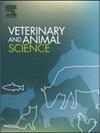高温条件下家兔纯种及其杂交种的生长性能、屠宰性状、血液分析及免疫反应
IF 1.9
Q2 AGRICULTURE, DAIRY & ANIMAL SCIENCE
引用次数: 0
摘要
本研究旨在探讨高环境条件下纯种杂交对生长兔生产性能的影响。185只8周龄生长兔的记录,代表4个遗传群(沙特本地、贾巴里;本试验选用进口西班牙V系)及其F2互交杂交种(¾J¾V和¾J¾V)。测定不同遗传群体的生长性能、胴体性状、血液参数和免疫反应。在F1和F2用Jabali品种作为母系时,杂交兔(3 / 4 J / 4 V)的屠宰率和有价值的肉块有较好的效果。与本地品种(Jabali)及其杂交品种相比,进口品种(V-Line)在高温环境下的生长性能受到的影响较小。与其他遗传组相比,进口v系兔的屠宰率最低。杂交品种(3 / 4 ~ 1 / 4)的胴体重、屠宰率、前腰切肉率最高。4个遗传组间各血液指标差异极显著(P<0.01)。与杂交品种相比,纯种品种的甘油三酯水平明显更高。24 h和72 h后,遗传组间细胞免疫差异有统计学意义。与本地品种及其杂交品种相比,高环境温度对进口品种生长性能有不利影响。然而,在肿胀差异曲线的较晚时间,可以看出Jabali(¾J¼V)衍生的杂交兔在细胞介导免疫方面的优势。研究结果表明,将Jabali品种作为母系纳入杂交计划可以提高产量和免疫性状,特别是在气候条件恶劣的地区。本文章由计算机程序翻译,如有差异,请以英文原文为准。
Growth performance, slaughter traits, blood analysis and immune response of rabbit pure breeds and their crossbreds under high ambient temperature
This study aimed to investigate the impact of crossbreeding between pure breeds on the performance of growing rabbits raised under high environmental conditions. Records of 185 growing rabbits aged 8 weeks representing four genetic groups (Saudi local, Jabali; imported Spanish V-Line) and their F2 reciprocal crossbreds (¾J¼V and ¼J¾V) were utilized in this experiment. The growth performance, carcass traits, blood parameters and immune response of the different genetic groups were determined. Superior effects of dressing percentage and valuable meat cuts were found in crossbred rabbits (¾J¼V), when the Jabali breed was used as a maternal line in F1 and F2. Compared with local breed (Jabali) and their crossbreds, the growth performance of the imported rabbit breed (V-Line) was less affected under high ambient temperature. Compared with the remaining genetic groups, the imported V-Line rabbits presented the lowest dressing percentage. The crossbreeds (¾J¼V) presented the highest values of carcass weight, percentage of dressing, and cuts of fore and loin parts. There were highly significant differences (P<0.01) between the four genetic groups for all studied blood parameters. Compared with crossbreds, the purebreds recorded significantly greater level of triglycerides. Cellular immunity was sig-nificantly different among the genetic groups after 24 and 72 h. Conclusions. A negative effect was observed of high ambient temperature on growth performance of imported rabbit breed compared to the local breed and their crossbreds. However, an advantage in cell-mediated immunity for crossbred rabbits derived from Jabali does (¾J¼V) was notice in the later time of swelling difference curve. The findings suggest that incorporating the Jabali breed as a maternal line in crossbreeding programs can enhance productive and immunological traits, particularly in regions with challenging climatic conditions.
求助全文
通过发布文献求助,成功后即可免费获取论文全文。
去求助
来源期刊

Veterinary and Animal Science
Veterinary-Veterinary (all)
CiteScore
3.50
自引率
0.00%
发文量
43
审稿时长
47 days
 求助内容:
求助内容: 应助结果提醒方式:
应助结果提醒方式:


